
The Sports Museum of Finland also known as the TAHTO is a museum specialising in sports and physical activity located at the Helsinki Olympic Stadium in Helsinki. [1] [2]

The Sports Museum of Finland also known as the TAHTO is a museum specialising in sports and physical activity located at the Helsinki Olympic Stadium in Helsinki. [1] [2]
The museum features more than 30,000 objects from various sports and sports culture. The oldest artifact is an ancient ski from c2,500 years ago. The collections include Teemu Selälä's ice hockey jersey and Mikael Forssell's football boots. The cultural centre receives its items mainly as donations. Famous sports figures, such as Paavo Nurmi and Kimi Räikkönen, have donated their equipment and prizes to the museum. [3]

The museum holds more than 300,000 photographs from the 1880s to the present day. The largest special collection is from the Helsinki Olympic Games in 1952: more than 10,000 negatives from the organisation of the Games to the closing ceremony. [4]

Helsinki is the capital and most populous city in Finland. It is located on the shore of the Gulf of Finland and serves as the seat of the Uusimaa region in southern Finland. Approximately 675,000 people live in the municipality, with 1.25 million in the capital region, and 1.58 million in the metropolitan area. As the most populous urban area in Finland, it is the country's most significant centre for politics, education, finance, culture, and research. Helsinki is situated 80 kilometres (50 mi) to the north of Tallinn, Estonia, 360 kilometres (220 mi) to the north of Riga, Latvia, 400 kilometres (250 mi) to the east of Stockholm, Sweden, and 300 kilometres (190 mi) to the west of Saint Petersburg, Russia. Helsinki has significant historical connections with these four cities.
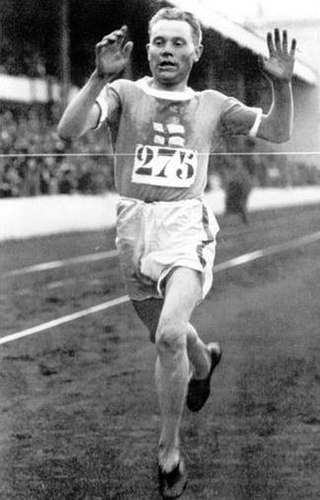
Paavo Johannes Nurmi was a Finnish middle-distance and long-distance runner. He was called the "Flying Finn" or the "Phantom Finn", as he dominated distance running in the 1920s. Nurmi set 22 official world records at distances between 1,500 metres and 20 kilometres, and won nine gold and three silver medals in his 12 events in the Summer Olympic Games. At his peak, Nurmi was undefeated for 121 races at distances from 800 m upwards. Throughout his 14-year career, he remained unbeaten in cross country events and the 10,000 metres.

The 1952 Summer Olympics, officially the Games of the XV Olympiad, and officially branded as the Helsinki Olympics, were an international multi-sport event held from 19 July to 3 August 1952 in Helsinki, Finland.
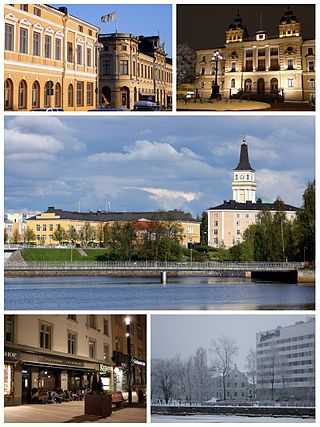
Oulu is a city in Finland and the regional capital of North Ostrobothnia. It is located on the northwestern coast of the country at the mouth of the River Oulu. The population of Oulu is approximately 215,000, while the sub-region has a population of approximately 263,000. It is the 5th most populous municipality in Finland, and the fourth most populous urban area in the country. Oulu is also the most populous city in Northern Finland.

Lahti is a city in Finland and the regional capital of Päijät-Häme. It is located in the Finnish Lakeland. The population of Lahti is approximately 121,000, while the sub-region has a population of approximately 204,000. It is the 9th most populous municipality in Finland, and the sixth most populous urban area in the country.

Pori is a city in Finland and the regional capital of Satakunta. It is located on the west coast of the country, on the Gulf of Bothnia. The population of Pori is approximately 83,000, while the sub-region has a population of approximately 129,000. It is the 10th most populous municipality in Finland, and the eighth most populous urban area in the country.

The Finland national football team represents Finland in men's international football competitions and is controlled by the Football Association of Finland, the governing body for football in Finland, which was founded in 1907. The team has been a member of FIFA since 1908 and a UEFA member since 1957.
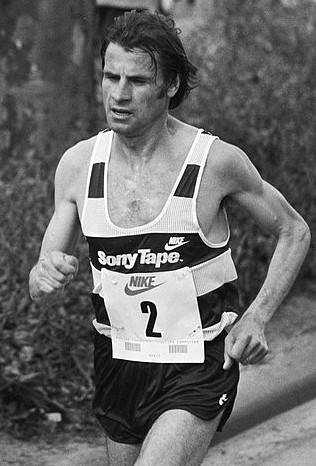
Carlos Alberto de Sousa Lopes, GCIH is a Portuguese former long-distance runner who competed for Sporting of Portugal at club level.

Helsinki-Malmi Airport was an airfield that served Helsinki, the capital of Finland, located in the district of Malmi, 5.4 NM north-north-east of the city centre. It was opened in 1936. Until the opening of Helsinki-Vantaa Airport in 1952, it was the main airport of Helsinki and of Finland. After that, it was used for general aviation and flight training, and remained the second-busiest airport in Finland, as measured by the number of landings, after Helsinki-Vantaa Airport. The city of Helsinki, which owns the land the airport is located on, terminated its lease agreement for aviation purposes in December 2019, and its remaining runway was closed in March 2021, but several legal complaints are pending in courts. The city plans to use the land for the construction of approximately 25,000 new apartments starting in 2024. The airfield area, including the runways and taxiways, was opened for public recreation in February 2022.
An Olympic Village is a residential complex built or reassigned for the Olympic Games in or nearby the host city for the purpose of accommodating all of the delegations. Olympic Villages are usually located close to the Olympic Stadium within an Olympic Park.

Athletes from Belarus began their Olympic participation at the 1952 Summer Games in Helsinki, Finland, as part of the Soviet Union. After the Soviet Union disbanded in 1991, Belarus, along with four of the other fourteen former Soviet republics, competed in the 1992 Winter Olympics as the Unified Team. Later in 1992, Belarus joined eleven republics to compete as the Unified Team at the Summer Games in Barcelona, Spain. Two years later, Belarus competed for the first time as an independent nation in the 1994 Winter Olympics, held in Lillehammer, Norway.
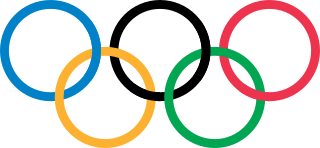
National Olympic Committees that wish to host an Olympic Games select cities within their territories to put forth bids for the Olympic Games. The staging of the Paralympic Games is automatically included in the bid. Since the creation of the International Olympic Committee (IOC) in 1894, which successfully appropriated the name of the Ancient Greek Olympics to create a modern sporting event, interested cities have rivaled for selection as host of the Summer or Winter Olympic Games. 51 different cities have been chosen to host the modern Olympics: three in Eastern Europe, five in East Asia, one in South America, three in Oceania, nine in North America and all the others in Western Europe. No Central American, African, Central Asian, Middle Eastern, South Asian, or Southeast Asian city has ever been chosen to host an Olympics.
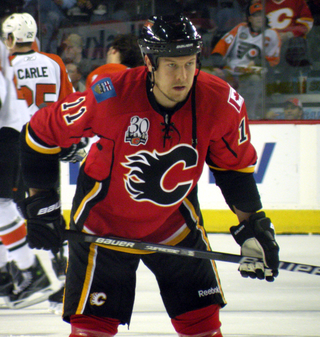
Niklas Hagman is a Finnish former professional ice hockey forward. He was a third round pick of the Florida Panthers, 70th overall, at the 1999 NHL Entry Draft and made his National Hockey League (NHL) debut with Florida in 2001. He has also played for the Dallas Stars, Toronto Maple Leafs, Calgary Flames and Anaheim Ducks in the NHL, Lokomotiv Yaroslavl in the KHL, HIFK, Espoo Blues and Kärpät in the SM-liiga and HC Davos in the Swiss National League A.

Venezuela competed at the 1952 Summer Olympics held in Helsinki, Finland. The Venezuelan Olympic Committee selected 38 competitors, 36 men and two women, to take part in 37 events across eight sports. This was a much greater turnout than 1948, Venezuela's only previous entry, which had only one athlete. For the first time, women represented Venezuela at the Summer Olympics. Women have been absent in the Venezuelan team on four occasions, including the next Summer Games held in Melbourne.
Ragnar Olof Jakob Stenberg was a Finnish sprinter and a sports leader.

Edvard Ferdinand Linna was a Finnish gymnast who won bronze in the 1908 Summer Olympics.

Väinö Edward Tiiri was a Finnish gymnast who won two Olympic medals.

Yrjö Erik Mikael Saarela was a Finnish wrestler, who won an Olympic gold and a world championship.
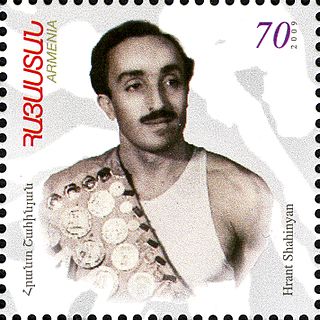
Hrant Shahinyan, also known as Grant Shaginyan, was a Soviet Armenian gymnast. Specializing in the still rings and pommel horse, he is a two-time Olympic Champion, two-time World Champion and seven-time USSR Champion.
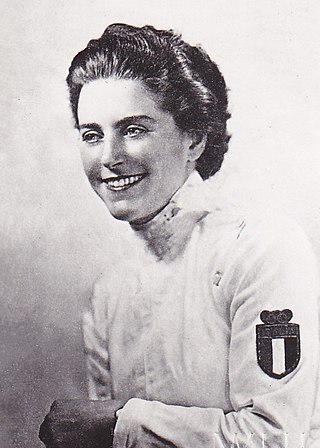
Irene Camber-Corno was an Italian fencer and Olympic champion in foil competition.